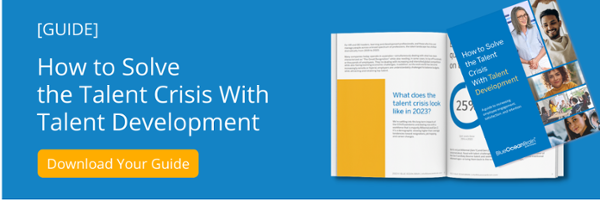Talent development has always been important for companies of all sizes, but arguably, in a post-COVID era where employee acquisition, engagement, and retention have become challenging and top-of-mind, it’s more important than ever before. Being effective in your talent development efforts can give you an edge. You’ll meet the needs of your employees—especially Gen Y and Gen Z employees who prioritize learning and development (L&D) at higher levels than their older colleagues (although all employees value L&D these days). And, you’ll help reskill and upskill employees to ensure they contribute positively to desired company outcomes.
All talent development activities aren’t equally valuable—or valued—though. When developing your talent development strategy, there are some critical best practices to adopt.
1) Striking balance between employee and company needs
There’s ample evidence to indicate that employees today want personal and professional development opportunities. In fact, they’re more likely to accept job offers from, and stay with, companies that offer these opportunities, according to research from LinkedIn and others. LinkedIn has found, for instance, that “opportunities to learn and grow” top the list of what employees expect from a great work culture—up from number nine in 2019.
But companies must get value from their learning and development investments as well. They must provide employees with the knowledge, skills, and competencies they need to help their organizations achieve strategic goals and objectives.
When planning and delivering learning and development activities, it’s essential to strike the right balance between both needs to ensure that employees will take advantage of these opportunities and that the company will benefit through greater engagement, productivity, and results. Offering maximum flexibility and options can help.
2) Focusing on flexibility in content and access
As many companies turned to digital learning during the pandemic to accommodate remote worker needs, they discovered something important—remote learning offered more options to reach more employees in more ways than ever before.
Without the need for employees to meet physically at a certain place and time for several hours, digital learning options offer flexibility, choice, and convenience. That increased participation and engagement.
Instead of two-hour, four-hour, or longer training sessions, training could be delivered in short bursts and made available both in real-time and on demand, offering maximum flexibility for employees to learn whenever and wherever they are.
A recent Harvard Business Review article points out that organizations find demonstrating their ROI from learning and development investments very challenging, with data indicating:
"To build L&D that works, employers must invest in programs that emphasize ROI, encouraging employees to learn not in the abstract, but directly in the flow of work."
The article also quotes Shelly Holt, former chief people officer at PayScale, who says:
“We need to create an environment where you learn, you practice, and you apply it. And it’s bite-sized. It’s not 7 hours of courses and then figure out how to do it.”
Employee training needs are varied. Offering a wide range of options employees can access anytime and anywhere can help meet those needs. Importantly, employees and their leaders need to understand what’s available and what benefits training options provide.
3) Think like a marketer
Communicating about learning and development opportunities needs to be ongoing rather than something that happens only during onboarding and the annual performance evaluation process.
Learning and development and HR leaders should take cues from their marketing colleagues about best practices in how to communicate to compel action. We know that employees are interested in professional development opportunities, but they have to know what is available, understand how to access them, and see a clear benefit from participation.
Communicating like a marketer means thoroughly understanding the needs of your audience—what’s important to them, what do they value, what are their pain points?—and convincing them that what you have to offer (your L&D solution) will address those needs.
That happens not through one communication effort but through multiple, ongoing efforts to remind them again and again of the value you have to offer.
Marketers also measure. As you communicate, it’s important to measure the effectiveness of your efforts. Which messages resonate really well? Which falls flat? Effective marketing is a continuous improvement process where each effort builds and improves on the last.
Your talent development strategy has the potential to help you address two related issues many businesses face today: a lack of engagement and high turnover. Effectively connect with your employees to provide them with the type of learning and development that meets their needs—both from a content and consumption standpoint—and you’ll keep them engaged and on board.
Ongoing talent development
Talent development must be varied to meet employees' needs and interests and easy to consume and access from wherever employees may be. This vastly improves employee engagement with L&D material and the company, decreasing low retention rates. And we can help!
Use our new eBook, Solving the Talent Crisis With Talent Development, for actionable tips on:
- What employees value in L&D today
- How talent development differs for the modern workforce
- How to reshape the post-pandemic employee experience
- L&D tactics to combat low engagement and turnover
Download the guide to learn more!




![[New eBook] Solving the Talent Crisis with Talent Development](https://blog.blueoceanbrain.com/hs-fs/hubfs/how-to-solve-the-talent-crisis.png?width=760&name=how-to-solve-the-talent-crisis.png)
